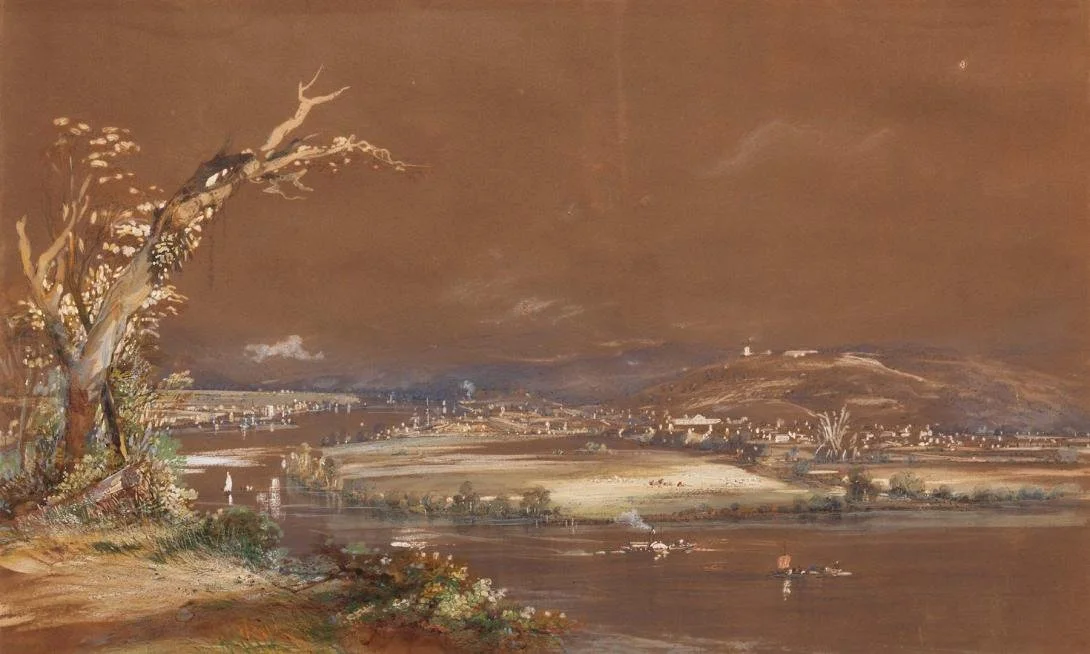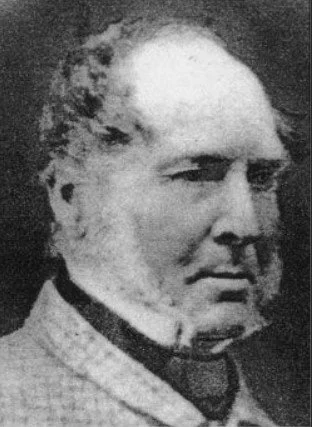Magistrate Wickham at Moreton Bay – Master of all he Surveyed
Conrad Martens “View of Brisbane in 1851” (painted from Bowen Terrace), QAGOMA Collection
Introduction
On 14 November 1842, Captain John Clements Wickham was appointed Police Magistrate for the District of Moreton Bay (District). He remained in the District until 1860.
His fiat as Police Magistrate was to administer the law in the District in the interests of the Government of New South Wales. Convict Transportation ceased in 1842, diminishing progressively the role of the District Military Commandant . This combination of circumstances was such that, while not in formal command of local government, he held the most senior bureaucratic position in the District thereby wielding extensive – if not near absolute – administrative control over entry to, and activity in, the District.
In 1853, Wickham was appointed as Government Resident, relinquishing his position as Police Magistrate.
For almost two decades, the major decisions about the peace, order and good government of the District fell to Wickham. He was a governor in all but name.
His character, however, was more manager than bureaucrat. As one historian writing of Wickham observed:
He showed much sympathy and understanding and exercised his authority with judgment and a genuine sense of responsibility; he had the confidence of the settlers and was able to contribute much to the early development of Brisbane.
Despite the competent performance of his duties during the formative years of the development of what became the colony of Queensland, Wickham, for the most part, has been written out of history.
Powerful Supporters
During the Third Voyage of the Beagle, of which he was master, Wickham had suffered terribly from illness.
On previous visits to Port Jackson, he had made the acquaintance of the family of Hannibal McArthur, brother of John McArthur of Camden.
Hannibal had married Anna Maria King who was the daughter of Phillip Gidley King, the third Governor of New South Wales. Anna Marie’s brother Phillip Parker King had served with Wickham in South America and would become the first Australian born Admiral in the Royal Navy.
Wickham became engaged to Hannibal and Anna Marie’s daughter Anne, however it was not until four years later, in 1842, they married on his retirement from the sea.
In short, Wickham, by marriage and as one of the most senior naval officers in the Colony of New South Wales, was at the heart of colonial affairs and government.
Early Years
Wickham and Anne arrived on the steamer Shamrock in early January 1843.
Accompanying them was the Reverend John Gregor who had been appointed Chaplain for the District, marking the foundation of the Church of England in the District.
While Moreton Bay had been a penal settlement from September 1824, the District was only opened to “free settlers” in 1842.
Upon arrival Wickham and Anne took up residence in the run-down Commandant’s Quarters until, in 1843, he purchased Newstead House – at the confluence of the Brisbane River and Breakfast Creek at Newstead – from the Leslie Brothers. They were successful squatters, and also Wickham’s brothers-in-law, having married Anne’s sisters.
Wickham and Anne took up residence at Newstead House along with three Galapagos tortoises called “Tom”, “Dick” and “Harry” (later re-named “Harriet”) which Charles Darwin gave Wickham on his second voyage on the Beagle. Upon Wickham’s 1860 departure from the District, Harriet lived in the Brisbane Botanic Gardens, and much later Australia Zoo, for another 150 years. See Part 1 in this series.
Wickham and Anne added substantially to Newstead House, and it came to be considered, if not officially as, Government House.
The 1846 Survey
By 1846 – to further trade in the colony – the Squatter funded District Improvement Fund financed a survey of Moreton Bay carried out by Wickham.
By all accounts, this was carried out with little difficulty and in a short time. Wickham was back doing what he knew best.
A further survey would be carried out in 1867 by his old shipmate from the third voyage of the Beagle, Captain Lort-Stokes, but then funded by the Admiralty.
Wickham’s Stewardship
Wickham’s effective performance as the senior government officer of the District is well evidenced by his management of the arrival of the Fortitude and the migrant ships that followed it.
Captain John Clements Wickham
The salient social issue in the District in the early years was the conflict between squatters, free settlers and “exiles”. The last were convicts from England and other penal colonies who were given “tickets of leave” upon reaching Moreton Bay.
1842 brought the end of transportation and thereby substantial free convict labour. Thus, labour, in particular skilled labour, was needed. This was serviced largely by the exiles.
Ultimately, disquiet amongst the free settlers saw an end to exile migration in 1850, by which time it was estimated about one quarter of the population of the District were exiles.
Contemporaneously, free settlers were arriving by ship with dubious promises of land and success. The squatters resented incursions by the free settlers and exiles.
In November 1849, Rev Dr John Dunmore Lang arrived on the Fortitude carrying some 300 selected immigrant artisans who Lang had promised would be granted land and be the backbone of the new free settler colony. It was the first of three ships chartered by Lang.
Wickham was instructed by the British Colonial Office not to allow the Fortitude to land and that the settlers be given no government assistance or rations. This command was irrational at the end of such an arduous voyage.
The solution struck by Wickham was to allow them to land and dwell over the hill to the north of the town of Brisbane, beyond its boundary. This today, of course, is now Fortitude Valley.
Lang’s second ship, Chastely, then arrived. Wickham made the old Convict Barracks in Queen Street available for the short term.
At the same time, two ships with exiles had been refused entry into Port Jackson and directed to Moreton Bay. One arrived just ahead of the third Lang ship, Lima.
Again, the official position was to render no assistance, but the immigrant settlers and exiles needed to come ashore. Wickham appreciated this reality.
Tensions, however, remained high. There was a meeting on 13 November 1849, where one settler is recorded as proclaiming that:
“he and others had given up such prospects as they had in the Old Country, and removed themselves and their families to this one in the hope and expectation that they would not be contaminated by association with convicts, and he objected to being placed in disadvantageous competition in this new country with the convicted felons of England. Let England keep her convicts, and let us have free, poor, but honest artisans.”
Whatever Wickham did to keep the peace is not well recorded, save that of course the Lang settlers left a lasting positive impact on the development and success on the later State of Queensland.
The above controversy, and the continued New South Wales administration direction to Moreton Bay of the exiles, advanced the cause of separatism at the behest of the free settlers, culminating in the creation in 1859 of the Colony of Queensland.
Dundalli
In 1855, as Government Resident, Wickham was the Chair of the Board of Inquiry into the Native Police investigating the conduct of its commandant.
He was also often the first point of complaint for dealings between the free settlers and the local indigenous groups.
Wickham was well informed and well regarded in respect to his knowledge and dealings with the local indigenous groups. He had great experience from the Beagle voyages working with Patagonian and other South American indigenous peoples.
After 1845, there was an escalation in tensions with the indigenous groups in Southern Queensland. In October 1846, pastoralist Andrew Gregor was killed along with his employee Mary Shannon.
Unease continued. Indigenous elder Dundalli was a leader of the local indigenous groups. In 1855 Dundalii was charged with the murder of Andrew Gregor and the trial was presided over by Justice Roger Therry.
Wickham gave evidence for Dundalii as to the unreliability of the primary witness. Yet immediately after giving evidence he sought and was granted leave ostensibly to see his eldest son depart Sydney for England.
Wickham was not in the District when Dundalii was convicted and hung on 5 January 1856.
It would be reasonable to conclude that Wickham’s giving of evidence in such a circumstance would not be received warmly in some quarters and that a price would be later exacted.
Family
Anne Wickham died in Sydney on 23 June 1852 aged 35.
Wickham and Anne had three children. The eldest, Charles, died on 1 August 1908, having reached the rank of Colonel in the Royal Artillery, serving most of his career on foreign postings, including in the Indian and Afghan conflicts.
On 1 October 1857, Wickham married Ellen Deerling, the daughter of prominent barrister John Deerling of Ipswich.
The couple had two children including Henry Falkland Wickham (you cannot take the sailor far from the sea).
Henry died in 1936 and is buried alongside his wife Elizabeth in Manly Cemetery in Sydney. Ellen passed away in 1896 and is buried at the Bald Hills Cemetery at Bracken Ridge.
Ambition Denied
From 1842 until 1859, Wickham was governor in all but name, which perhaps explains his bitterness at not being appointed as the First Governor of Queensland upon separation in 1859.
Wickham was offered a junior posting which he refused to accept.
It seems that the patronage of Prime Minster Gladstone apropos of first Governor Sir George Bowen was far more important than the service to the infant colony rendered by Wickham.
Bowen did however support the request by Wickham for a pension and compensation for loss of office which was otherwise refused by the newly formed Queensland Government and the request referred to New South Wales which also refused saying it was a Queensland issue. Wickham went bereft.
In early 1860, Wickham left on the Duncan Dunbar with his wife and family and returned to England, never again to set foot in the District he had served for one quarter of his life.
He had given up his rank as Captain in the Royal Navy to come ashore to serve for 17 years during the formative years of growth of the District, providing stability while it progressed towards establishment as a separate colony, but was left disappointed and destitute. In 1864 he died in Biarritz, western France, in strained financial circumstances.
No Memorial
Other than the naming of the two well-known thoroughfares – Wickham Terrace and Wickham Street – no memorial was ever established for Wickham. It was not until 1937 that a visiting grandson funded the erection of a memorial plaque at Newstead House.
Plaque at Newstead House



